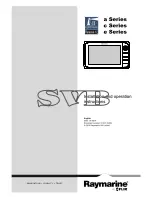
App-14
IM 2560A-01EN
Appendix 8 About the IEEE 488.2-1992 Standard
The 2560A’s GP-IB interface conforms to the IEEE 488.2-1992 standard. This standard specifies that the following 23
items be stated in the document. This section describes these items.
(1) Of the IEEE 488.1 interface functions, the
subsets that are supported
See section 9.1, “GP-IB Interface Features and
Specifications.”
(2) The operation of the device when it is assigned
an address outside the 0 to 30 range.
The address of this instrument cannot be set to an
address outside the 0 to 30 range.
(3) Reaction of the device when the user changes
the address
The address change is detected when the user uses
the RANGE dial > SETUP > GP-IB menu > ADRS
menu and changes the address. The new address
is valid until the next time it is changed.
(4) Device settings at power-up. The commands
that can be used at power-up.
As a basic rule, the previous settings (the settings
that were in use when the 2560A was turned off) are
used.
There are no limitations on the commands that can
be used at power-up.
(5) Message exchange options
(a) Input buffer size
1024 bytes.
(b) Queries that return multiple response
messages
See the example of the commands given in
chapter 13.
(c) Queries that create response data when
the command syntax is being analyzed
All queries create response data when the
command syntax is analyzed.
(d) Queries that create response data during
reception
There are no queries of which the response data
are created upon receiving a send request from
the controller.
(e) Commands that have parameters that
restrict one another
See the example of the commands given in
chapter 13.
(6) Items that are included in the functional or
composite header elements constituting a
command
See chapters 12 and 13.
(7) Buffer sizes that affect block data transmission
When block data is being transmitted, the output
queue is expanded to match the size of the data that
is being transmitted.
(8) A list of program data elements that can be used
in equations and their nesting limitations
Equations cannot be used.
(9) Syntax of the responses to queries
See the example of the commands given in chapter
13.
(10) Communication between devices that do not
follow the response syntax
Not supported.
(11) Size of the response data block
0 bytes
(12) A list of supported common commands
See section 13.7, “Common Command Group.”
(13) Device condition after a successful calibration
*CAL is not supported.
(14) The maximum length of block data that can be
used for the *DDT trigger macro definition
Not supported.
(15) The maximum length of the macro label for
defining macros, the maximum length of block
data that can be used for the macro definition,
and the process when recursion is used in
macro definitions
Macro functions are not supported.
(16) Reply to the *IDN? query
See section 13.7, “Common Command Group.”
(17) Size of storage area for protected user data for
*PUD and *PUD?
*PUD and *PUD? are not supported.
(18) The length of the *RDT and *RDT? resource
names
*RDT and *RDT? are not supported.
(19) The change in the status due to *RST, *LRN?,
*RCL, and *SAV!!!BREAK HERE!!!*RST
See section 13.7, “Common Command Group.”
*LRN?, *RCL, *SAV
These common commands are not supported.
(20) The extent of the self-test using the *TST?
command
See section 13.7, “Common Command Group.”
(21) The structure of the extended return status
See chapter 12.
(22) Whether each command is processed in an
overlapped manner or sequentially
See section 12.5, “Synchronization with the
Controller” and chapter 13.
(23) The description of the execution of each
command
See the functions of the commands given in chapter
13.





































